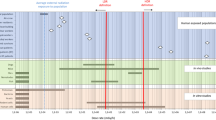Summary
The effects of microwave hyperthermia (41° and 43° C) on virus multiplication have been exploredin vitro (HSV-1 infected primary rabbit kidney cultures) andin vivo (mice infected with HSV-1 or vaccinia).
In vitro the cells were inoculated with HSV-1 and heated to 41° or 43° C either before or after infection. Virus yields were significantly decreased when the cells were exposed to hyperthermia within the first few hours after infection, while hyperthermia was without effect when applied before infection or with several hours delay after infection.
In mice inoculated intranasally with HSV-1, mortality due to herpes encephalitis was significantly reduced upon daily exposure to microwave hyperthermia from the day of infection onward.
In mice inoculated intravenously with vaccinia, a significant decrease in the number of specific tail lesions was observed if the animals were exposed to microwave hyperthermia within the first three days after infection, while irradiation prior to infection or delayed until several days after infection did not exhibit an appreciable effect.
Our data suggest that microwave hyperthermia interferes directly with the virus multiplication cycle bothin vitro andin vivo.
Similar content being viewed by others
References
Bowler, K., Dunkan, C. J., Gladwell, R. T.: Cellular heat injury. Comp. Biochem. Physiol.45 A, 441–450 (1973).
Carpenter, R. L., Livstone, E. H.: Evidence for non-thermal effects of microwave radiation—abnormal development of irradiated insect pupae. Institute of Electrical and Electronics Engineers Trans.MTT-19, 173–178 (1971).
Cavaliere, R., Rossi-Fanelli, A., Mondovi, B., Moricca, G.: Selective heat sensitivity of cancer cells. Recent Results in Cancer Research. Heidelberg-New York: Springer 1976.
Cleary, S. F.: Uncertainties as to the specific (non-thermal) effect of microwaves. Health Physics20, 38–46 (1973).
de Clercq, E., Luczak, M.: Intranasal challenge of mice with herpes simplex virus: experimental model for evaluating the efficacy of antiviral drugs. J. inf. Dis.133 (suppl.), A 226-A 236 (1976).
de Clercq, E., Luczak, M., Shugar, D., Torrence, P. F., Waters, J. A., Witkop, B.: Effect of cytosine arabinoside, iododeoxyuridine, ethyldeoxyuridine, thiocyanatodeoxyuridine and ribavirin on tail lesion formation in mice infected with vaccinia virus. Proc. Soc. exp. Biol. Med.151, 487–490 (1976).
Dietzel, F.: Tumor und Temperatur. München: Urban u. Schwarzenberg 1975.
Guy, A. W., Lehmann, J. F., Stonebridge, J. B.: Therapeutic application of electromagnetic power. Proc. Institute of Electrical and Electronics Engineers22, Suppl. 1, 55–75 (1974).
Larcher, W., Heber, U., Sattariud, K. A.: Limiting temperatures for life functions. In:Precht, H.,et al. (eds.), Temperature and Life, 195–292. Berlin-Heidelberg-New York: Springer 1973.
Leeper, D.: Hyperthermia—effects of different temperatures on normal and tumor cells. Proc. Int. Symp. Cancer Treatment by Hyperthermia, Washington, 28–30 April 1975. Radiology, Supplement, in press (1976).
McLees, B. D., Finch, E. D.: Analysis of reported physiologic effects of microwave radiation. Adv. Biol. Med. Physics14, 164–225 (1973).
Muckle, D. S., Dickson, J. A.: The selective inhibitory effect of hyperthermia on the metabolism and growth of malignant cells. Brit. J. Cancer25, 771–778 (1971).
Overgaard, K., Overgaard, J.: Investigations on the possibility of a thermic tumour therapy—short wave treatment of a transplanted isologous mouse mammary carcinoma. Eur. J. Cancer8, 65–86 (1972).
Precht, H., Christophersen, J., Hensel, H., Larcher, W. (eds.): Temperature and Life. Berlin-Heidelberg-New York: Springer 1973.
Sisken, J. R., Morasca, L., Kibby, S.: Effects of temperatures on kinetics of mitotic cycle of mammalian cells in culture. Exp. Cell Res.39, 103–116 (1965).
Suit, H. D., Shwayder, H.: Hyperthermia—potential as an antitumor agent. Cancer34, 122–129 (1974).
Szmigielski, S., Bielec, M.: Microwaves as a tool for intensive locel hyperthermia in cancer treatment. Proc. Int. Symp. Cancer Treatment by Hyperthermia, Washington, 28–30 April 1975. Radiobiology, Supplement, in press (1976).
Szmigielski, S., Luczak, M., Wiranowska, M.: Effect of microwaves on cell function and virus replication in cell cultures irradiatedin vitro. Ann. N.Y. Acad. Sci.247, 263–272 (1975).
Wüst, G. P., Norpoth, K., Witting, U., Oberwittler, W.: Derin-vitro-Effekt der Hyperthermia auf den Einbau von Nukleinsäurevorläufer in Tumoren und normalem Gewebe. Ztschr. Krebsforsch.79, 193–201 (1973).
Author information
Authors and Affiliations
Additional information
With 3 Figures
Rights and permissions
About this article
Cite this article
Szmigielski, S., Luczak, M., Janiak, M. et al. In vitro andin vivo inhibition of virus multiplication by microwave hyperthermia. Archives of Virology 53, 71–77 (1977). https://doi.org/10.1007/BF01314848
Received:
Accepted:
Issue Date:
DOI: https://doi.org/10.1007/BF01314848




